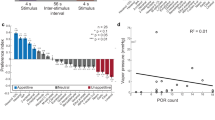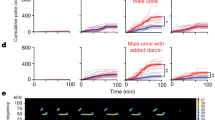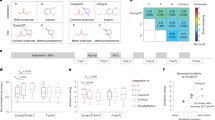Abstract
The prevailing view of the mammalian olfactory system is that odorants are detected only in the nasal olfactory epithelium, whereas pheromones are generally detected in the vomeronasal organ1,2,3. Here we show that vomeronasal neurons can actually detect both odorants and pheromones. This suggests that in mammals, as in insects4,5,6, odorous compounds released from plants or other animal species may act as 'semiochemicals' — signalling molecules that elicit stereotyped behaviours that are advantageous to the emitter or to the receiver.
Similar content being viewed by others
Main
To investigate the function of the vomeronasal organ, we used calcium imaging of single murine vomeronasal neurons containing Fura-2 dye7,8. As with olfactory neurons in the nose, resting concentrations of intracellular calcium were about 20–40 nM in vomeronasal neurons and were increased to about 120–150 nM by 100 mM potassium chloride7. We found that vomeronasal neurons from both males and females respond to six mouse pheromones that stimulate aggression, subordination or alteration in puberty onset or oestrus (Fig. 1a, b)9. Individual pheromones (100 μM) stimulated 0.3–0.7% of the neurons, most of which responded to only one pheromone, as shown previously10.
Calcium imaging7 was used on dissociated VNs containing Fura-2 during exposure by perfusion to pheromones (a, b) or odorant mixes/odorants (c–h) (4 seconds each) and then to 100 mM KCl. Fluorescence emission (at 510 nm) from cells illuminated at 380 nm was monitored (Fi, fluorescence intensity in arbitrary units)7. Scale is the same for all traces. The lack of response to all concentrations (10−10–10−4 M) of an odorant in h may be due to transient desensitization. Odorant (and other) mixes: animalic (A), camphoric (Ca), citrus (Ci), floral (Fl), fruity (Fr), green minty (G), musky (M), sweet (S), woody (W), aliphatic (Ali) and amino acids (AA). Pheromones: dehydro-exo-brevicomin (B), 2-heptanone (H), 2,5-dimethyl pyrazine (D), 2-sec-butyl-4,5-dihydrothiazole (T), E,E-α-farnesene plus E-β-farnesene (F) and lactol (L). Single odorants that elicited responses: indole (A1), hexadecanolide (M4), muscone (M5), patchone (W8) and durene (Ca3); as well as (not shown) p-cresol (A2), eucalyptol (Ca1), isoborneol (Ca4), borneol (Ca5), fenchone (Ca6), butyrophenone (Ca7), methylanisole (Ca8), myrtenal (Ca9), phenafleur (Fl5), dimethyl-3-octanol (Fl8), helional (Fl10), pentadecalactone (M3) and aubepine (S1).
Surprisingly, mouse vomeronasal neurons also detect odorants (Fig. 1; Table 1). We assembled 82 odorants (50 μM each) in 9 mixes and found that neurons responded to several of these mixes. Vomeronasal neurons that responded to an individual mix were tested against each odorant in the mix. Altogether, 0.1–1.5% of neurons responded to a single mix (Table 1). Neurons were also activated by 18 single odorants classified as animalic, camphoric, floral, musky, sweet or woody (Fig. 1).
We found that, like olfactory neurons7,8, vomeronasal neurons were activated by more than one odorant or mix, but they can also distinguish between highly related odorants such as indole and skatole, which differ by a single methyl group (Fig.1c). Like pheromones10, the three odorant mixes tested activated vomeronasal neurons (n = 6) at 10−10 M (Fig. 1h), which is much less than is required for an olfactory neuron to respond, indicating that the vomeronasal organ is highly sensitive to low concentrations of both pheromones and odorants.
Vomeronasal neurons detected many of the odorants we tested (18 out of 82). It is unlikely that so many odorants would be released from mice as pheromones. But why does the vomeronasal organ detect odorants? In contrast to the olfactory epithelium, there is no direct pathway from this organ to the higher cortical areas involved in odour perception and discrimination1,2,3. Instead, inputs are targeted to the amygdala and hypothalamus, areas that control hormone levels, emotions, basic drives and instinctive behaviours. Like pheromones, some odorants may stimulate innate behavioural or physiological responses.
As in insects, certain odorants may act in mammals as semiochemicals that influence behaviour. Volatile chemicals emitted by plants can elicit oviposition or pollination in insects, and those released from prey can stimulate prey-finding behaviours4,5,6. A prey protein detected by the vomeronasal organ of the garter snake also induces tracking activity1. Certain odorants in the natural habitat of mice may similarly provide cues that signal the presence of a predator or indicate the suitability of a particular site for feeding or nesting.
References
Halpern, M. Annu. Rev. Neurosci. 10, 325–362 (1987).
Wysocki, C. J. & Meredith, M. in The Neurobiology of Taste and Smell (eds Finger, T. E. & Silver, W. L.) 125–150 (Wiley, New York, 1987).
Buck, L. B. Cell 100, 611–618 (2000).
Binder, B., Robbins, J. & Wilson, R. J. Chem. Ecol. 21, 1315–1327 (1995).
Dobson, H., Groth, I. & Bergstroem, G. Am. J. Bot. 83, 877–885 (1996).
Kielty, J., Allen-Williams, L., Underwood, N. & Eastwood, E. J. Insect Behav. 9, 237–250 (1996).
Sato, T., Hirono, J., Tonoike, M. & Takebayashi, M. J. Neurophysiol. 72, 2980–2989 (1994).
Malnic, B., Hirono, J., Sato, T. & Buck, L. B. Cell 96, 713–723 (1999).
Novotny, M., Jemiolo, B. & Harvey, S. in Chemical Signals in Vertebrates (eds Macdonald, D. W., Muller-Schwarze, D. & Natynczuk, S. E.) 1–21 (Oxford Univ. Press, Oxford, 1990).
Leinders-Zufall, T. et al. Nature 405, 792–796 (2000).
Author information
Authors and Affiliations
Corresponding author
Rights and permissions
About this article
Cite this article
Sam, M., Vora, S., Malnic, B. et al. Odorants may arouse instinctive behaviours. Nature 412, 142 (2001). https://doi.org/10.1038/35084137
Issue Date:
DOI: https://doi.org/10.1038/35084137
This article is cited by
-
Structural, morphometric and immunohistochemical study of the rabbit accessory olfactory bulb
Brain Structure and Function (2020)
-
Expansion of vomeronasal receptor genes (OlfC) in the evolution of fright reaction in Ostariophysan fishes
Communications Biology (2019)
-
Detection of pup odors by non-canonical adult vomeronasal neurons expressing an odorant receptor gene is influenced by sex and parenting status
BMC Biology (2016)
-
Identification of two distinct genes at the vertebrate TRPC2 locus and their characterisation in a marsupial and a monotreme
BMC Molecular Biology (2011)
-
Acquisition of Pavlovian Fear Conditioning Using β-Adrenoceptor Activation of the Dorsal Premammillary Nucleus as an Unconditioned Stimulus to Mimic Live Predator-Threat Exposure
Neuropsychopharmacology (2011)
Comments
By submitting a comment you agree to abide by our Terms and Community Guidelines. If you find something abusive or that does not comply with our terms or guidelines please flag it as inappropriate.




